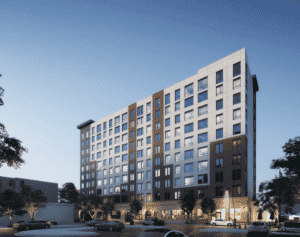
Market-rate housing can combat economic segregation in Massachusetts’ Gateway Cities. Lynnfield-based Procopio Cos. completed the Caldwell apartment tower, which includes 259 market-rate units in downtown Lynn, in mid-2021. Photo courtesy of Procopio Cos.
Despite our population becoming far more diverse, people of color moving to the suburbs, and white households returning to the cities, it is extremely difficult to find a public school in Massachusetts today that is both racially and ethnically diverse and economically integrated.
This means most students will not get the benefit of learning alongside others with different backgrounds, cultures and perspectives. For low-income students, our segregative patterns are downright toxic. Children from families with limited income are increasingly concentrated in high-poverty schools that cost them years of academic growth. Research shows this “economic segregation” pours more fuel on the fires of rising inequality than automation, globalization and de-unionization combined.
Real estate developers that have long sought to build more complete communities can bemoan this situation, but they should not lose all hope. Change is in the air.
One major difference is educators are increasingly speaking out about the problem. For decades, education policy leaders enforced the dogma that high-poverty schools should function just as effectively as others, if only teachers believed in their students and set higher expectations for them. It’s clear now that this is fallacy, and furthermore, separating students to the extent that we have seriously undermines the social fabric and one of the core purposes of public education.
The second major difference is we can come to the fight with guns and money. With federal stimulus funds, the state has hundreds of millions of dollars to support mixed-income housing development. The new Housing Choice law that Gov. Charlie Baker so valiantly led the way to pass makes it easier for suburbs to adopt inclusive zoning ordinances, and it requires towns with MBTA commuter rail stations to allow multifamily housing by right. If we can build mixed-income projects with family-sized units in these zones, we can expand our affordable housing inventory, create more housing stability for families with limited means and give them much greater access to low-poverty school districts.
But we mustn’t stop there. Urban communities, particularly our Gateway Cities, will need a complementary reinvestment strategy to attract middle-class families to their neighborhoods. This piece is critical; simply pulling low-income families out of cities would be disastrous.
A Simple Formula for Growth
The mechanics of an effective strategy are simple.
First, build market-rate housing in Gateway Cities. Downtown adaptive reuse projects position these communities to attract and retain young professionals as they approach childbearing age.
The state’s Housing Development Incentive Program (HDIP) has been enormously successful. If we were to increase funding for the incentive so this gap-closing equity was available to any developer seeking to make these projects financially feasible, tens of thousands of units would appear in Gateway Cities overnight.
The next task is getting Millennials to put down roots, moving them from their lofts and into Gateway Cities’ neighborhoods and public schools. School systems can draw middle-class parents with a portfolio of options that are attractive to them, including dual-language immersion schools, Montessori schools and arts magnets.
As we invest in new school facilities, we must target and coordinate neighborhood revitalization efforts in the area. Addressing blight and reinvigorating commercial strips will help ensure that a shiny new school building draws a diverse mix of students.
Time to Pull Together
For this “school centered neighborhood revitalization” formula to succeed, cities, public school districts and real estate developers must all pull in the same direction.
Many of the firms building in Gateway Cities today have the talent to make these complicated community partnerships work. Cities need to up their game. School departments must learn to partner, not just externally with developers who know how to find creative ways to channel investment into struggling neighborhoods, but also across city government with planning and community development agencies.
School integration is as thorny a subject as you can come by in Massachusetts, but public opinion data suggest residents want leaders to find solutions. Most parents appreciate that their children benefit from exposure to students from different backgrounds and prefer integrated learning environments, if only they could find them. Leaning in together, we can create high-quality integrated schools in Gateway Cities just as surely as we can build housing that lower-income families can afford in the suburbs.
Ben Forman is the research director at the nonpartisan think tank MassINC and co-author of the new report Choosing Integration: A Discussion Paper and Policy Primer.




 |
| 

